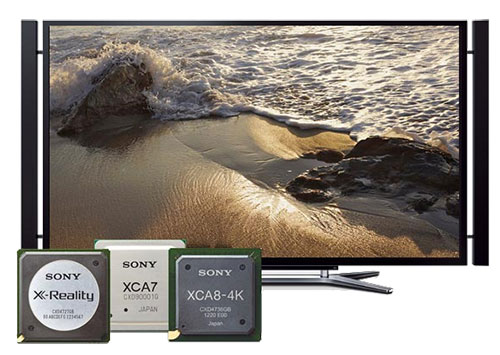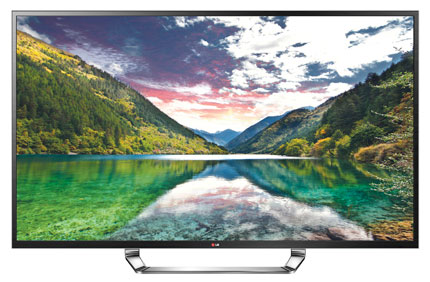
|
|
 |

|


 What in the HD World? What in the HD World?CEA Rebrands 4K Displays as Ultra HD
Dick De JongOctober 25, 2012 HDTV Solutions Well, it's official, the 4K format of TVs and projectors has been renamed Ultra HD. After much deliberation, a committee formed by the Consumer Electronics Association, (those folks that organize the mega CES Convention), has decided that Ultra High-Definition or Ultra HD would be a better moniker for these 4K resolution displays than more unwieldy terms like Quad Full HD or 4K2K. You can read the details in the CEA press release. Since 4K TVs are just beginning to hit the marketplace and climbing to the top of fantasy wish lists of cutting edge videophiles, CEA's adoption of Ultra HD is really a pre-emptive strike against the confusion that often arises with various manufacturers using different names for the same technology. For example, is 1080p the same thing as FullHD? But perhaps CEA was a bit premature, since it isn't quite clear if all 4K TVs will be compatible. But I imagine that after format wars like the Blu-ray/HD DVD donnybrook, TV manufacturers will agree on standardizing their 4K TVs and the Ultra HD name will stick as the de facto standard for displays whose "minimum performance attributes include display resolution of at least eight million active pixels, with at least 3,840 horizontally and at least 2,160 vertically." If you are doing the math, these displays have four times the resolution of the 1080p HDTVs (1920 x 1080) that are common today. And from the 4K prototypes that I have witnessed, the image quality difference over 1080p TVs can be stunning, especially when the 4K TV is displaying native 4K content. But currently, there is no consumer-available 4K content in the form of movies or TV shows. Blu-rays are 1080p and if you watch them on an Ultra HD TV, they will be upscaled to 4K by the TV, in a similar manner that 1080p HDTVs upscale standard definition DVDs.  The 84" Ultra HD Sony XBR-84X900 and its video processor chips Until studios start producing 4K DVDs, one of the critical tests of Ultra HD displays will be how well they upscale lower resolution content like Blu-rays. Until I get up close and personal with an Ultra HD set and spin a stack of my favorite Blu-rays, I won't have that answer. When will we see commercially available 4K content? There are hundreds of movies already digitally mastered in a 4K format. If you have been to your local megaplex theater lately, chances are you've watched a movie projected digitally in either 4K or 8K resolution. As the Ultra HD displays become less expensive - the first 4K TVs from LG and Sony are priced over $20,000 - and more people own them, sooner than later, we'll see Ultra HD DVDs. Or perhaps by that time, we will have multi-gigabit bandwidth on our home networks and we will just stream Ultra HD from Netflix or VUDU. If you can't wait, chances are you have a 4K content creator in your pocket or purse. If you have an 8 megapixel camera on your cellphone, you are capturing 4K images, (depending on the aspect ratio, somewhere around 4000 x 2000 pixels), that you can view in full resolution on a Ultra HD display. Actually, when I first saw a prototype 4K TV a few years back, the first thing that came to my mind is that the display would be perfect for a photographer. Now, about that over 20K price tag, both Sony and LG are rolling out 84" Ultra HD models. The screen stretches seven feet diagonally, 7'! The TV is about the size of a twin bed mattress and weighs over 150 pounds. It's huge and you can begin to understand the equally oversized price.  The 84" Ultra HD LG 84LM9600 is available now in the U.S. for around $20,000. So why 84"? I reckon it was a corporate decision that entailed everything from panel supply chains to eyeball-drawing impact in big box showrooms. And even though 4K resolution can really flaunt its advantages at this size, Ultra HD TVs should also be winners at smaller sizes, especially if the price premium over HD TVs shrinks accordingly. The audience will be there. The popularity of Apple's Retina display has already shown that buyers are willing to pay a little extra for a boost in resolution and image quality. We are definitely in the early stages of the 4K display evolution, but coining the Ultra HD brand is a savvy first step. It certainly has a nice marketing ring. I can hear the discussions in TV showrooms across the country, "But, honey, it's Ultra HD!" or "Dude. FullHD is so yesterday. Ultra HD is Awesome HD." And while I'm peering into the future, Panasonic and NHK, a Japanese broadcaster, recently showcased a 145-inch 8K plasma TV, which has four times the pixel resolution of Ultra HD (and 16 x 1080p HD). CEA hasn't announced a new term for 8K yet. Here's your chance to make your mark on the TV vernacular for years to come. What should 8K be called? Extreme HD or OMG HD! Hit the Comments and give it your best shot. Stay tuned.
|
Bookmark:
![]() del.icio.us
del.icio.us
![]() Reddit
Reddit
![]() Google
Google
Reader Comments
| Send this Page | Print this Page | Report Errors |


Posted Jan 17, 2013 3:20:26 PM
By stewebabe